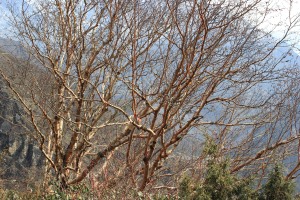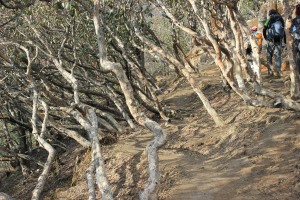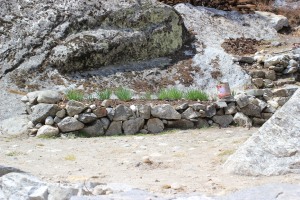So I’m home. Back from Nepal. I’ve been to Base Camp, got the t shirt. (I really have got the t shirt….) And now it’s back to horticulture, and planting plans, and all those other things that seemed a very long way away at 5,400 metres.
So I thought I’d get back into the swing of things by writing about the plants I saw on my travels.To be fair this is a totally inaccurate title for this post….. Because there are in fact very few plants at all at Base Camp. In fact precisely none. Apart from some incredibly determined lichen and mosses. Nothing lives up there for very long. But I’m suffering from jet lag…. And looking for dramatic effect. So I’m just going to stick with this title and see where it takes me.
Landing at the tiny airport in Lucla the first thing that strikes you are the wild rhododendron.  The green foothills are dotted with splashes of pink and purple and carmine red. Prayer flags strung up in the trees add their own unique touch of character. Wild pieris grow much taller and more stately than I’ve ever seen them at home, and the rough slopes are dotted with soft purple primula. Clumps of bamboo stand alone. And as we walk up the steep paths the scent of wild daphne hangs in the warm air.
The green foothills are dotted with splashes of pink and purple and carmine red. Prayer flags strung up in the trees add their own unique touch of character. Wild pieris grow much taller and more stately than I’ve ever seen them at home, and the rough slopes are dotted with soft purple primula. Clumps of bamboo stand alone. And as we walk up the steep paths the scent of wild daphne hangs in the warm air.
The scenery changes as we go higher. A birch with papery red bark can be see everywhere rubbing shoulders with the rhododendron and pine. 

 In certain places its bare branches are hung with swathes of a soft green lichen that I haven’t seen before. There’s low growing cotoneaster, eidelweiss twinkling by the edges of the pathway, and tall pines framing the view at every new corner.
In certain places its bare branches are hung with swathes of a soft green lichen that I haven’t seen before. There’s low growing cotoneaster, eidelweiss twinkling by the edges of the pathway, and tall pines framing the view at every new corner.  It is breathtaking, magical, extraordinary. I’m seeing plants that are very familiar to us in the UK, but in their natural setting. They look very content to be here.
It is breathtaking, magical, extraordinary. I’m seeing plants that are very familiar to us in the UK, but in their natural setting. They look very content to be here.
The interesting thing is the way the plants get closer to the ground as we get higher up. Juniper in particular – trees shrink to low growing shrubs as the altitude takes effect. There is lots of wild berberis and a wild rose that isn’t out yet but must look sensational when it is.  The rhododendron are reduced from thirty to twenty to ten foot trees, their stems twisting and turning in on themselves as if they really want to grow taller but have lost their nerve.
The rhododendron are reduced from thirty to twenty to ten foot trees, their stems twisting and turning in on themselves as if they really want to grow taller but have lost their nerve.
The one thing that remains constant wherever there are people to be found, at whatever height, is the use of all and any patch of land, no matter how challenging, to grow  vegetables.
vegetables.

 Yak dung is the fertiliser of choice. Potatoes and cabbages, onions and root vegetables are harvested and then buried back into their fields to protect them from the intense cold. They are dug up when they are needed.
Yak dung is the fertiliser of choice. Potatoes and cabbages, onions and root vegetables are harvested and then buried back into their fields to protect them from the intense cold. They are dug up when they are needed. 
 And there is even a vegetable garden in the courtyard of the Patan museum in the centre of Kathmandu.
And there is even a vegetable garden in the courtyard of the Patan museum in the centre of Kathmandu.
And finally – flowers for colour are grown in whatever the people can lay their hands on – paint pots, buckets, tin cans.
 You have to love this country……
You have to love this country……

